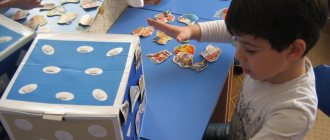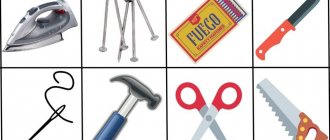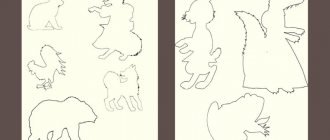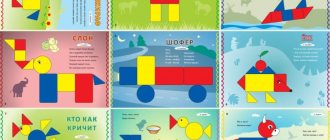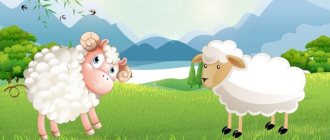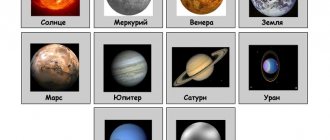Article "Game as a means of economic education of older preschoolers."
Author: Kotenkova Natalya Leonidovna
Annotation.
This article examines the relevance of economic education for older preschoolers. Economic education occurs through gaming activities: role-playing games and didactic games.
Keywords:
economic education, economics, game.
The Law “On Education” of the Russian Federation and the “Concept of Preschool Education” emphasize the priority of universal human values. [1] Therefore, in the conditions of maintaining the economic independence of Russia, its scientific potential and the development of modern Russian society, the economic education of the younger generation becomes significant.
In other words, modern children have to live in new conditions, master fundamentally new professions that require new knowledge, professional and personal qualities. Thus, modern new economic conditions dictate the need to educate independent, active, active, hardworking, economically literate, highly moral, humane people from preschool age, which is the basis for the further life of the individual. [2]
Therefore, economic education, a relatively new direction in preschool pedagogy, is currently relevant and in demand.
Only at first glance, economics and a preschooler seem too far apart. The child is included in the economic life of the family very early, encounters money, advertising, goes to the store with his parents, participates in the process of buying and selling, thus mastering economic information on an everyday level. It is in the family that he first learns the price of labor, income and expenses, the advantages of material well-being, prosperity and poverty. Understood as the area of “smart housekeeping,” the “art of housekeeping,” economics is inseparable from a child from the earliest years of his life. [10]
Economic education is part of the general education system, an organized pedagogical process aimed at developing a caring attitude towards the surrounding world of values, another facet of the educational process. [9]
Economic education is understood as the result of economic education, contributing to the formation of an economic attitude towards material and spiritual values and the formation of the principles of value orientations. [eleven]
In our opinion, the effectiveness of economic education is largely determined by what moral foundation is laid in the child’s personality. In the process of economic education, along with the assimilation of basic economic categories, the formation of moral qualities of preschoolers, hard work, frugality, efficiency, occurs, which is expressed in actions and behavior.
The goal of economic education is to reveal to the child the objective world around him, as a world of spiritual and material values, as part of universal human culture, and in the process of cognition, to teach appropriate forms of behavior. [12]
In order for a child at school to have a good understanding of complex economic concepts, work in this direction must begin from the age of 5–6 years in close cooperation with parents. After all, according to psychologists, at the border of preschool and school age, there is a closure of connections between the two most important spheres of life - the world of human relations and the objective environment. One world gives way to another. It is during this period that a leap occurs in the formation of personality and its basic mental foundations. And naturally, adults cannot lose sight of this period. This is what happens in a growing person’s assessments, judgments, and attitudes toward good and evil. [5]
Considering that preschoolers have a predominance of visual-figurative thinking and the main type of activity is play, play activity becomes the main means of economic education for a 5-7 year old child.
Playing for a child is a serious activity. “To make a serious activity entertaining for a child is the task of initial education,” said K.D. Ushinsky. [7]
An analysis of psychological and pedagogical literature shows that the problem of the content of economic education of older preschoolers is very complex and ambiguous; teachers highlight various aspects: economic education of preschool children (AA Smolentseva); formation of the foundations of economic culture (E.A. Kurak); introducing children to the economy, initial economic education as one of the factors of economic socialization, which has a huge impact on the child’s developing relationship with material and spiritual values and, in general, on the development of the child’s personality (A.D. Shatova); the formation of economic socialization of children (E.V. Kozlova); formation of economic knowledge in children of senior preschool age (JI.H. Galkina); children's awareness of economic concepts (DA. Golub).
Those. the process of economic education occurs spontaneously, fragmentarily, the holistic theory of economic education of preschool children has not been sufficiently developed, and the problem of economic education of older preschoolers through play has not been sufficiently studied, in this regard, the program “Game as a means of economic education of older preschoolers” has been developed.
The goal of the program is the economic education of older preschoolers (this is the process of forming an economic outlook, mastering economic ideas and concepts, initial economic skills, acquiring such personality traits as hard work, frugality, efficiency) through play activities.
Tasks:
1. Introduce children to the theoretical basis of economic sciences (through familiarization with the most accessible economic concepts, familiarization with modern market relations).
2. To develop skills of caring for all types of property, respect for the interests of the individual and other members of society, instilling respect for work and working people.
3. Development of gaming activities.
4. Fostering the necessary qualities in children (respect for the objective world, nature, etc.).
5. Formation of skills of reasonable behavior and needs.
The program is designed for two years (1st year of study - children 5-6 years old, 2nd year of study - 6-7 years old) and is divided into blocks. At the age of 5-6 years, 4 economic categories are studied: needs; work; product; money.
At the age of 6-7 years, the process of mastering 8 economic categories is underway: economics; profit and loss; needs; money ; labor (professions); advertising; barter; business and capital.
I began my work by preparing methodological support. Methodological publications by L.G. Kireeva, A.A. Smolentseva, E.A. Kurak, and A.D. Shatova became the main manuals for the implementation of economic education.
It is known that the development of a child depends on many factors, including the relevant environment, i.e. the environment in which it occurs. Therefore, it is so urgent to create a subject-development environment in a preschool educational institution - the space in which the child lives and develops: the natural world, the world of people, the world of the subject-spatial environment. [13]
The group has created a corner “Economic ABC”, in which there is a map of the city, which shows the industrial centers of our city, as well as large stores. The development environment was supplemented with the following board and printed games on economics: “Monopoly”, “money”, “supermarket”, “what is made of what”, “sweets and coins”, “professions”, “economics”, etc. To the role-playing game in the “Shop” game, a cash register was purchased, checks and money were made., for the “Bank” game - receipts, a computer layout, money, I created a card index of economic concepts, which I regularly replenished as I studied the material. A did card index has also been developed. games.
Cooperation with parents played a significant role, so I spoke at a parent meeting with information on the topic of economic education “Preparing a child for life.”
Parents really like that their children study economics, and they help us in every possible way to raise our children “economically.” After all, the “first economic experience” is acquired in the family. Therefore, the children in their families tried out the economic experience acquired in the classroom: they distributed family needs according to importance (what to spend money on first, what to spend money on last), drew up a family budget, bought food, saved household resources (electricity, water), took care of to everything in the house.
In my work, I use story-based didactic games, which are both educational and educational. Such a game has a detailed plot, including a variety of roles, where certain game problems are solved directly on the basis of acquired mathematical knowledge and are offered to the child in the form of game rules. Plot-based didactic games help make economics understandable for children through modeling real life situations: buying and selling, production and marketing of products, etc. [3]
With the help of story-based and didactic games, I help children enter the complex world of objects, things, and human relationships.
On the theme “labor - product - commodity” I organize such games as: “Atelier”, “Furniture workshop”, “Market”, “Shop” “Hospital”, “Pharmacy”, “Hairdresser”, “Builders”, “Farmers” . Children comprehend the meaning of labor and reproduce the labor processes of adults. During the game, children use a variety of materials and master labor operations for the manufacture of various goods.
The goal is to give children knowledge in the field of financial categories, to form an idea of a product as a result and product of human labor, to develop skills in evaluating objects in terms of their quality and cost, moral and labor qualities of an individual through a comparative analysis of one’s own and others’ work, and also to consolidate skills evaluate a thing as a commodity and as an object of human relations. Preschoolers got acquainted with professions - traditional (games “I Know All Professions” and new ones (for example, advertising agent, advertiser, banker), the importance of various types of work for a person. I tried to convey to the children’s consciousness that there are no bad or good, necessary or unnecessary professions, everyone is necessary. It doesn’t matter what a person’s profession is, what matters is how he does his job, what benefits he brings to people.
On the topic “money and price,” I include in children’s activities a game that involves operations with coins of different denominations and values, and the exchange of money. These are games such as “Small Shopping”, “Market”, “Pharmacy”, “Bank”. During such games, children learn that every thing costs money and learn to compare the price of an item with the available cash. Children are introduced to the concept of a bank - a place where they lend money, change it, store it and pay it back.
When playing “Shop” and “paying” for purchased goods, preschoolers do not pay attention to the value of money. You can often hear from children: “I had one piece of money, and now I have several (two, three, five, etc.),” so there were classes dedicated to familiarizing preschoolers with Russian banknotes. To trace the history of Russian money, the folder “History of Russian paper money” was created. During classes, children learned that there is paper money - bills and metal - coins, money has dignity, and not always one bill or coin is less than two or three. They clarified the names of banknotes - rubles and coins - kopecks, what denominations of money are used in our country, and introduced the children to currency.
For this purpose, she introduced preschoolers to such concepts as “salary”, “pension”, “family budget”, they explained what it consists of, what goods and services the family’s money is used to pay for, because it is no secret that many children perceive money in my parents’ wallet as money to buy toys and sweets. We often hear in a store: “Mom, buy ...” - and we see with what bewilderment the child greets the mother’s statement that she does not have money: after all, he just saw it in her wallet. In order for the children to understand where the money earned by family members goes, we discussed with them possible options for spending the money. At the same time, we proceeded from the life experience of preschoolers: they go with their parents to the store for groceries, to the savings bank to pay for utilities, long-distance telephone calls, etc.
Plot-based didactic games on the topic “advertising” give children the opportunity to practically carry out the process of creating advertising. Introducing children to the work of an advertising agent, advertiser, and graphic designer.
The formation of “useful skills and habits in everyday life” occurs in various plot-based didactic games: “Atelier”, “Furniture Workshop”, “Market”, “Hospital”, “Pharmacy”, “Hairdresser”, “Builders”, “Farmers”, “Bank”, “Auction”, “Factory”, “Travel Agency”, etc. In addition, she taught children to conserve the country’s resources: water and electricity. She conducted play sessions “The Journey of Kapa and Droplets”, “How Gnome Economy Saves Electricity”, during which she explained to the children where water and electricity come from in the house, why they are needed, why they are expensive, etc. Children no longer forgot to turn off the tap behind them and reminded adults to turn off the lights.
In my work, I relied on the empirical knowledge and life experiences of children, trying to clarify and expand their ideas in the field of economics.
I also used didactic games as a means of forming the foundations of economic culture. The main feature of didactic games is that tasks are offered to children in a playful way. They play without suspecting that they are mastering knowledge, mastering skills, and learning a culture of communication and behavior. All didactic games include cognitive and educational content, which allows you to integratively solve problems in developing the foundations of economic knowledge in older preschoolers. [4]
During the experimental work, didactic games were included in the content of classes and were carried out outside of them. For the emergence of independent didactic games in the group, the necessary conditions were created: appropriate didactic material and manuals were selected. To increase interest, didactic games of different content and types were used: with objects, with pictures, printed board games, verbal economic games, as well as travel games, riddle games, conversation games, guessing games, etc. [13]
The use of games in economic education plays a positive role. Children are more successful in acquiring economic knowledge and applying it in games. It can also be noted that children have begun to treat their personal and kindergarten belongings much more carefully and are trying to save material in productive activities. We learned to think logically, reason on economic topics, and formulate conclusions.
Positive feedback has also been received from parents. The teachers received special thanks for their work on the topic of family budget and its rational use. Children began to react with understanding to their parents’ refusals to buy things they didn’t really need.
At the end of the year, a diagnostic test was carried out on economic knowledge. Her results showed that there were more children with a high level of development, and children from a low level moved to an average one. So the high level was in 3 and became 10 children, the average level was in 13 - became 9, the low level was in 4 - became 1.
Economic education brings a preschooler closer to real life, allows him to acquire the qualities inherent in a real owner who knows how to count money, and develops the business qualities of an individual, which ensures continuity between kindergarten and school.
List of sources used
1. Federal Law of December 29, 2012 N 273-FZ “On Education in the Russian Federation”.
2. Preschoolers about economics: a guide for teachers of institutions providing preschool education / E.N. Tabih. – Minsk: Vysh. school, 2011. – 48 p.: ill.
3. Playing economics: comprehensive classes, role-playing games and didactic games / author - comp. L.G. Kireeva. – Volgograd: Teacher, 2012 – 169 p.
4. Knyshova L.V., Menshikova O.I., Popova T.L. The economy of milking babies, or How Misha became a businessman. – M.: Pedagogy – Press, 2011 – 118.: ill.
5. Lushnikova E.V. How we play economics //Teacher of the preschool educational institution “TC SPHERE” M.; 2008. No. 11. p.75.
6. Raizberg B.A., Lozovsky L.Sh., Tsymuk M.I. Children's economic dictionary. Publishing house "Rosmen" M.: 1999. – 192 p.
7. Smolentseva A.A. Introduction to the world of economics, or How we play economics: Educational and methodological manual, - St. Petersburg: “Childhood - Press”, 2011. – 176 p.
8. Smolentseva A.A. Problem-based game technology for economic education of preschoolers // Kindergarten from A to Z. 2003. No. 4. p.63.
9. Shalamova T.P. Introducing children to the world of economics // Kindergarten from A to Z. 2003. No. 4. p.89.
10. Shatova A.D. Preschooler and ... economics // Hoop. 1999. No. 1.
11. Shatova A.D. Do preschoolers need economic education and why? // Preschool education. 1994. No. 8
12. Shatova A.D. Discussing the problem “Economy and ... children” // Kindergarten from A to Z. 2003. No. 4. p.148
13. Economic education of preschool children: Sample program, long-term planning, lesson notes / Under.
ed. E.A. Kuraka. – M.: TC SPHERE, 2012. – 80 p. comments powered by HyperComments
Financial vocabulary for kids
- A bank is a place where people can carry out various transactions with money.
- Deposit is money that was brought to the bank and given to be kept there.
- An ATM is a device that allows you to withdraw or deposit money onto a bank plastic card.
- Assets are anything that brings in money.
- Liabilities are what take money.
- Money is pieces of paper or coins that serve as a general exchange. For example, for money you can buy anything in a store, or go to the movies. Different countries have different money.
- Card - fully called a bank payment card. This is a piece of plastic that you can use to pay for purchases in stores, online, and many other places.
- A loan is money that a person, if he lacks for something, can ask to borrow from a bank. For example, if you want to buy a computer, but you don’t have enough money, the bank can lend you money. But then the bank will have to repay the debt and pay interest.
- A bill or banknote is what paper money is called. A bill or banknote is one piece of paper.
- Cash flow or profit is the difference between income and expenses over a period of time.
The following types of coins and banknotes are currently in use in Russia:
